Bell peppers are a tasty fruit that humans love to eat. Can Hamsters Eat Bell Peppers? Bell peppers are an excellent addition to any hamster’s diet. They provide a source of natural sugars, which help keep your pet healthy and active. However, there are some side-effects associated with feeding excessive bell peppers to your pet.
Hamsters are omnivores and should be given a varied diet. Bell peppers, which are low in calories and provide nutrients like vitamin C, potassium, fiber, and vitamin B6. They also contain lycopene, which is beneficial for preventing certain cancers. Your hamster will enjoy the taste of these fruits as well as their crunchy texture!

Can hamsters eat bell peppers safely? Can you feed your hamster with bell peppers? What are the advantages of feeding your hamster bell peppers, and what are the disadvantages of doing so?How do I buy the best kind of pepper for my pet, and how can I make sure they will like it before buying it?
I will answer all these basic questions in this article!
What Exactly Are Bell Peppers?
Bell peppers, also known as sweet peppers or capsicums, are a fruit of the capsicum plant. They come in different shapes and colors, such as red, green, yellow, and orange, depending on their ripeness. Most bell peppers have a mild flavor that makes them an excellent addition to any hamster’s diet.
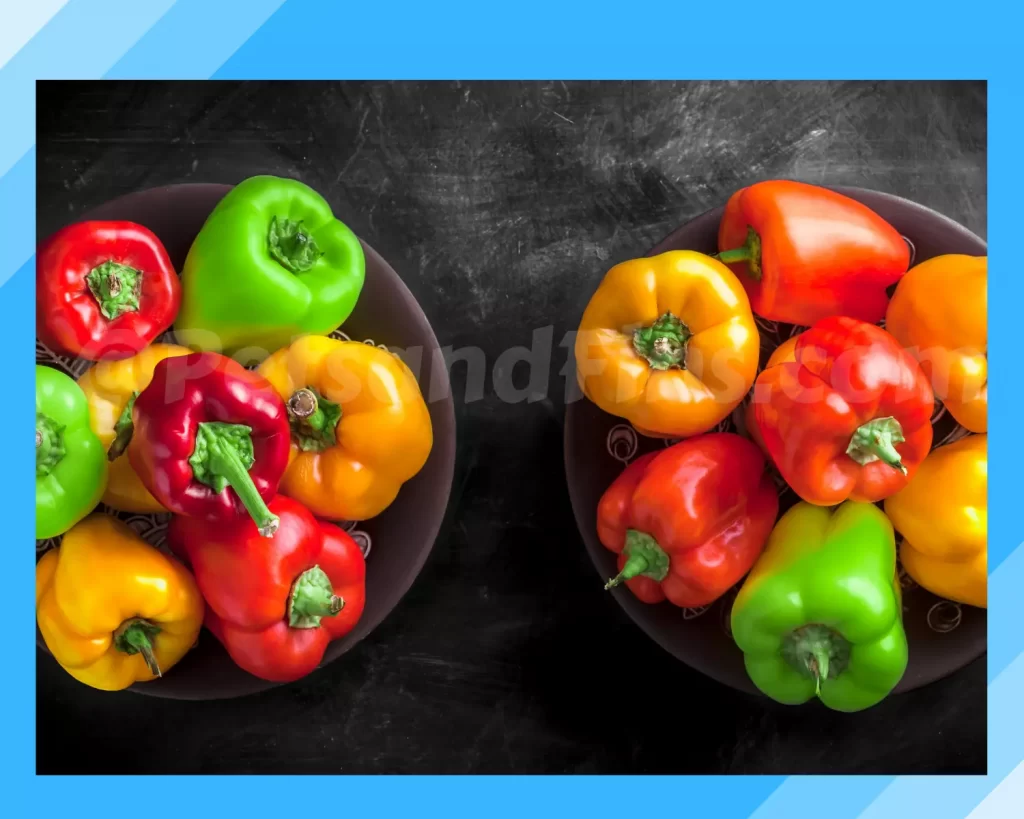
Bell peppers are a popular fruit that can be used in salads and as an ingredient in various cuisines. The best time to buy these fruits is in the summer when they are abundant, cheap, and taste the sweetest!
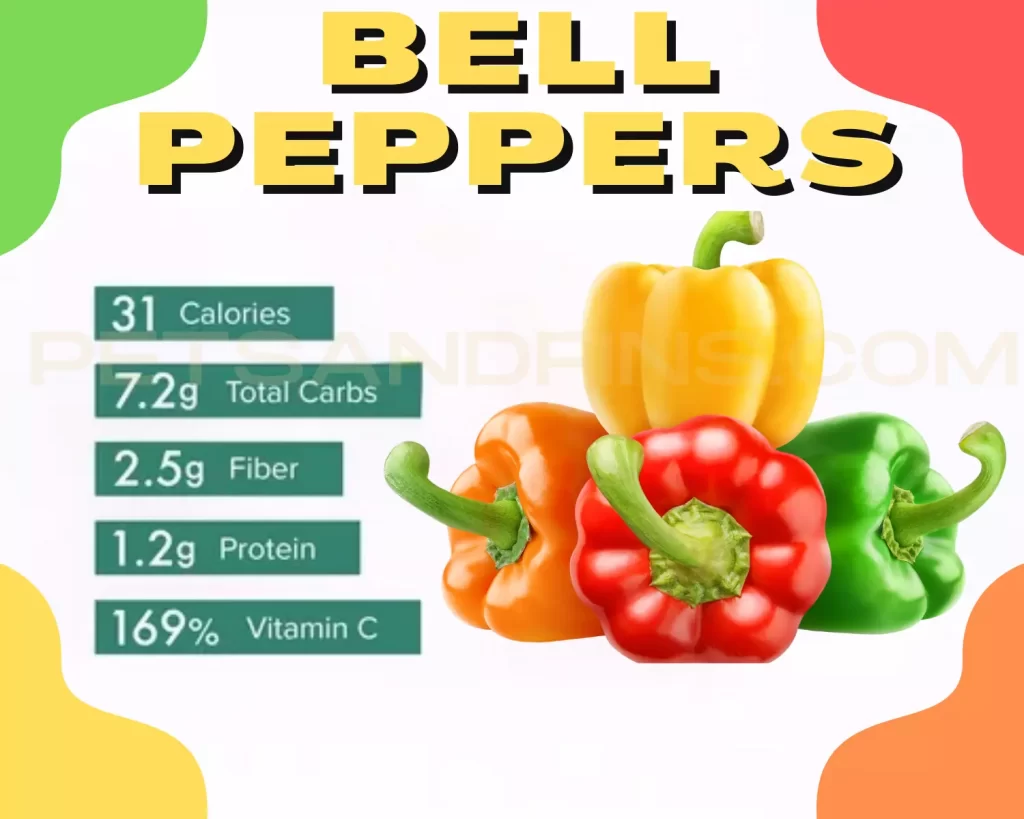
Can Hamsters Eat Bell Peppers?
Yes! You can safely offer your hamster a taste of bell peppers . If fed in moderation, they will provide a healthy source of nutrients and energy for your furry friend without any side-effects. However, be sure not to overfeed them, as it has been shown that excessive intake may lead to obesity or diabetes.
Although the exact nutritional values vary between species (for example; Syrian/Golden Dwarfs tend to have more delicate stomachs), all kinds of hamsters are able to benefit from the health benefits associated with bell peppers.

Bell peppers contain important nutrients that can benefit both young and adult hamsters. If fed in moderation, they will provide a tasty treat for your furry friend.
Hamsters should not solely rely on one type of food when it comes to their nutrition since this diet lacks variety, which leads to malnutrition over time. Bell peppers make an excellent addition to any kind of balanced diet because they contain lycopene (vitamin A) and beta-carotene (vitamin A precursors), vitamin C, fiber, potassium and B-complex groups of vitamins.
Benefits Of Bell Peppers For Your Hamster:
There are several benefits associated with it. Bell peppers contain many vitamins that can benefit both young and adult hamsters alike.
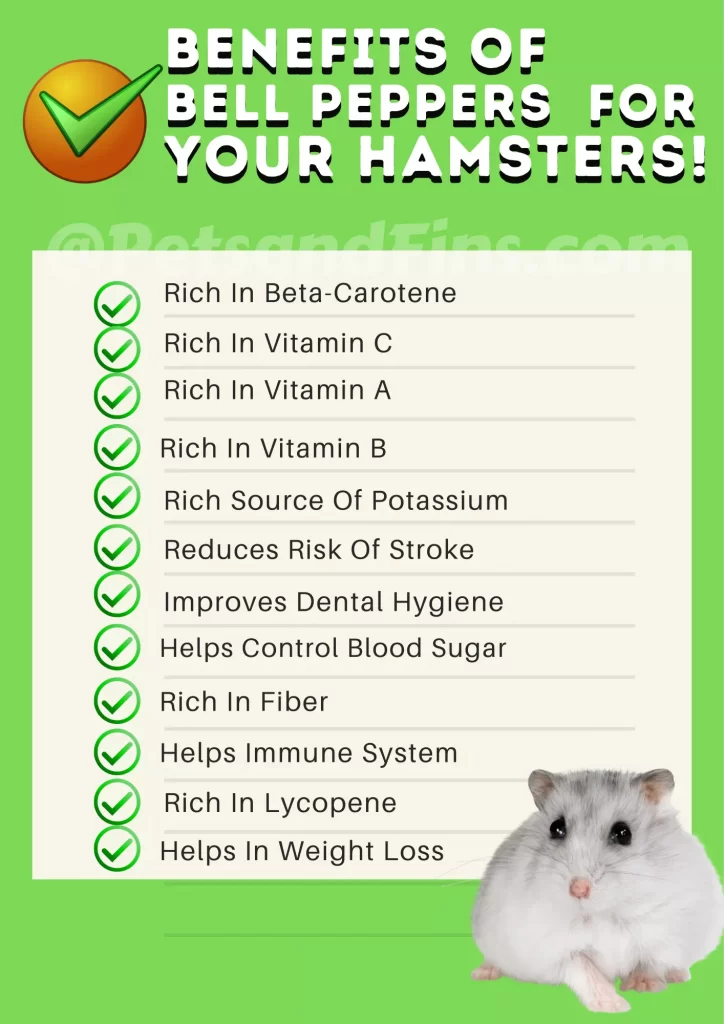
- Rich In Vitamin C: Vitamin C is essential for the growth and repair of all cells in a healthy body . It also plays an important role in maintaining teeth, bones , cartilage, muscles, blood vessels , gums, as well as skin health.
In addition to promoting wound healing and preventing infections caused by bacteria or viruses , vitamin C has been shown to protect against cancer (specifically lung cancer) when consumed at high levels through fruits such as red pepper !

- Rich In Vitamin A: Vitamin A is essential to prevent night blindness , dry skin, and rough coat.It also plays an important role in maintaining healthy mucus membranes (in the respiratory, digestive and urinary tracts).
In addition, vitamin A encourages a strong immune system while fighting free radicals in the body by neutralising their effects on cells. Red chili contains seven times more beta-carotene than carrots.
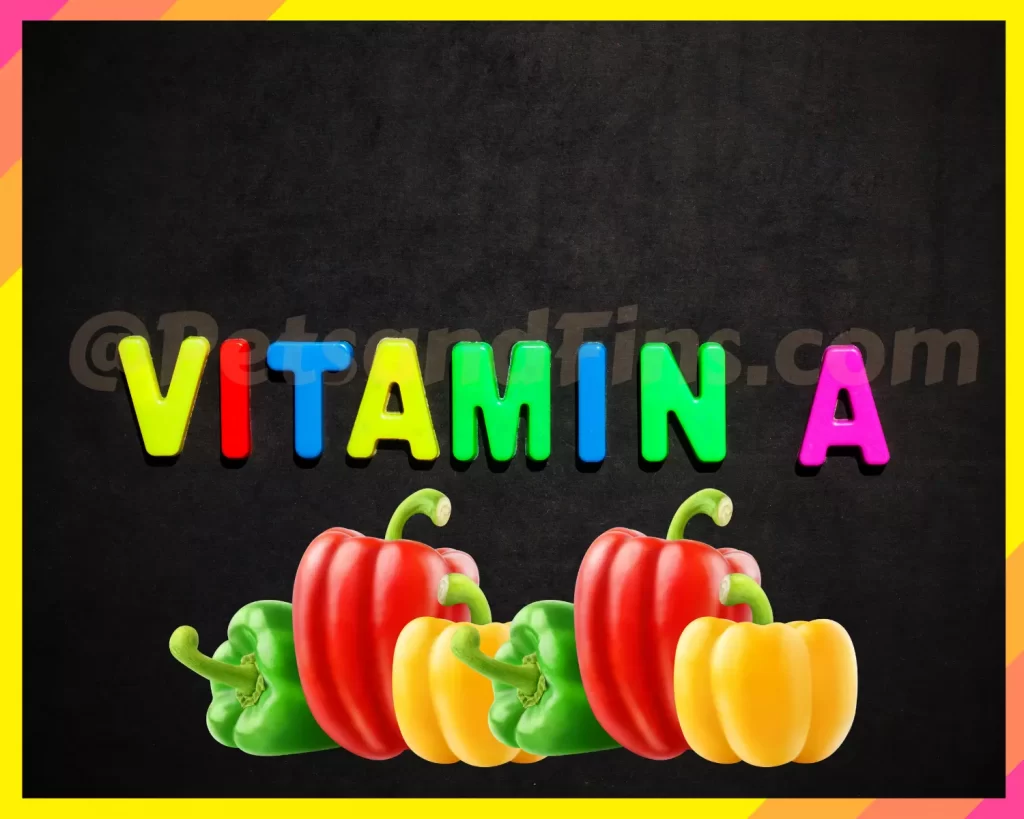
- Rich In Potassium: Potassium helps fluid balance within the body while also regulating the proper function of our nerves, blood pressure , and heart. .Bell peppers are an excellent source of potassium.
- Rich In Fiber: When your hamsters are fed a high fiber diet, it works by slowing down your pet’s digestion, which helps maintain more consistent blood sugar levels over time. It may even help reduce the risk of diabetes when given in sufficient amounts on a daily basis !
- Rich In Vitamin B Complex: Vitamin B complex refers to all eight water soluble vitamins (vitamins B and C) essential for maintaining health. By eating bell peppers, your hamster will be able to receive a good amount of vitamin B complexwhich can help with metabolism , hormonal balance, and brain function .
- Rich In Beta-Carotene: Beta-carotene is the precursor form of Vitamin A that must first be converted into this powerful antioxidant for our bodies to use. It has been associated with several health benefits, including cancer prevention , healthy vision (especially related to night blindness), and reducing age-related macular degeneration (AMD).
- Rich In Lycopene: Lycopene is an important carotenoid antioxidant and phytonutrient found in red colored fruits such as bell pepper. Not only does lycopene have potent antioxidant properties, but it also acts like an immune system modulator and can reduce oxidative stress (damage) to cells.

- Aids In Weight Loss:There are many benefits of feeding your hamster with bell peppers. These fruits have a low caloric content, which makes them an excellent treat for overweight pets. They also help fight obesity by providing healthy nutrients without too many calories!
- Diabetic Friendly:Bell peppers are a healthy treat with no calories, fat or cholesterol! This makes them an excellent choice for hamsters that have diabetes since their glycemic index is low .
Side Effects Of Excessive Bell Peppers For Hamsters:
Although the nutritional benefits associated with this fruit should not be ignored, there are certain side-effects that can occur if given in excess.
- Weight Gain : The first one has to do with weight gain . If fed on a daily basis for an extended period , it may result in obesity or other health complications related to excessive body fat (such as insulin resistance, which is characteristic of type II diabetes).
- Gastrointestinal Issues:Secondly, bell peppers contain capsaicin which acts like pepper spray when consumed at high levels! It will cause gastrointestinal irritation and possible ulcers/lesions over time due to its spicy nature.
- Diarrhea Or Loose Stools : Another side-effect that is most often associated with eating bell peppers is excessive diarrheaor loose stools. .Since bell peppers are rich in fiber, these symptoms will likely be more pronounced after eating too many at once.
If this happens to your hamster frequently , then it would probably be wise to limit their intake or avoid them all together .
- Electrolyte Imbalance:Too many bell peppers mean too much potassium, which leads to electrolyte imbalances in the blood, preventing cells from getting enough oxygen from their blood supply . This results in fatigue and weakness, as well as affects cardiovascular function, leading to heart problems or even a stroke!
- Malnutrition: Last but not least, bell peppers are very low in certain key nutrients, such as protein . As a result , your hamster may develop malnutrition if they consume too much of this fruit without other sources to compensate.
What To Do If My Hamster Has Eaten Excessive Bell Peppers ?
You can take the following steps to counter the effects of eating too many Bell Peppers
- Keep Them Hydrated: If your hamster has eaten too many Bell peppers ,you can give them some fresh water .This will help avoid further complications due to dehydration, such as seizures and urinary tract infections!
- Offer Some Coconut Water: You can also offer some coconut water to help them get rid of excess potassium.
- Keep An Eye Out For Diarrhea: If they have eaten too many bell peppers and start having diarrhea, you should avoid giving your hamster any more food for at least twenty-four hours until the situation improves! You should then give them their regular diet but in smaller amounts.
- Change Their Diet:You need to change their diet during this time by avoiding fruits for a few weeks. Instead, you should focus on giving your hamster more protein and healthy fats. You can then gradually introduce some fruits back into their diet over the next few weeks to see if they have any allergies or negative reactions.
If your hamster is suffering from any of the following symptoms, you should immediately take them to a veterinarian:
- Lethargy or weakness in muscles
- Diarrhea for more than 24 hours that prevents normal bowel movements which may become bloody.
- Inability to eat or drink anything even after several hours
- Swollen abdomen and/or tummy area which is often accompanied by a loss of appetite for more than 24 hours.
- Seizures
Your furry friend may need antibiotics, special fluids given intravenously, and other medications to correct their condition.If you notice these types of behaviors, it’s important to take your hamster to the vet immediately!
Although most cases are not serious and your hamster will probably recover within a day, if you notice that they are suffering from any of these symptoms, it’s best to get them checked out.
Recommended Serving Size Of BellPeppers For Your Hamster:
The best way to benefit from the nutritional value of bell peppers for your hamster is by feeding them a small amount about once per week.Never give more than one tablespoon of bell pepper per day.
I would recommend giving your hamster about 1 tablespoon of chopped bell pepper twice a week. This is in case you have a larger variety of hamsters, such as the Syrian hamster. For smaller varieties of hamsters, such as dwarf hamsters, you can further reduce and give a maximum of 1/2 tablespoon of bell pepper, twice per week.
How To Introduce Bell Peppers In To My Hamster’s Diet?
The best way to introduce bell peppers to your hamster’s diet is by feeding them small amounts of them at a time, and increasing the amount gradually.
You should start with just one very small piece and only give more if they don’t show any signs of having an allergic reaction such as diarrhea or skin irritation .
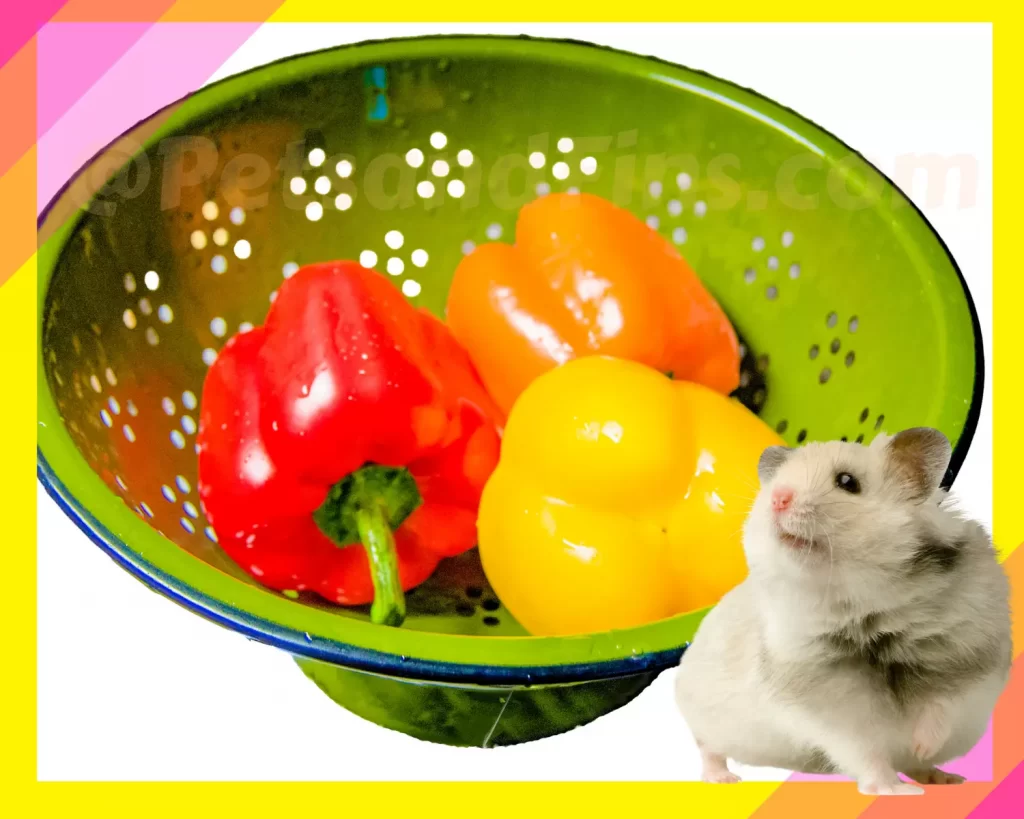
If you want to introduce bell peppers to your hamster’s diet, there are a few steps that you should follow.
Step One: Introduce the bell pepper in a safe manner.
The first thing that you need to do is choose a time when your furry friend isn’t feeling too hungry or aggressive. If they have just been fed, they will be less likely to want more food.
Step Two: Put Very Tiny Bell Pepper Pieces in the Cage
Next, you need to put a few bell pepper pieces inside your hamster’s cage and leave them for about fifteen minutes before checking on their reaction. You should also make sure that there are no other animals or pets around that might want to eat the Bell Pepper too.
Step Three: Watch Their Reaction
If your hamster seems comfortable with their new food, you can slowly start giving them bigger pieces of fruit within a few days. Just make sure that they are still getting enough protein and calcium from other parts of their diet.

Step four: Add more bell pepper pieces.
You can increase the amount of fruit that you give your hamster by about one tablespoon every few days of the week.
Step 5: Keep an eye on their weight and hydration.
It’s important to monitor your hamster’s weight and hydration as they begin eating bell peppers.If their tummy starts getting bigger or you start noticing that they are having diarrhea, it may be a sign of too many carbs in their diet which can lead to obesity and other health problems.
Step Six: Offer Bell Peppers In Moderation
Make sure to offer bell peppers in moderation while monitoring their weight and health carefully. You should also keep a close eye on them during the first few weeks so you can spot any potential issues early on!
How To Feed Bell Peppers To My Hamster:
There are several ways in which you can incorporate some bell peppers into their diet.
- Mix It With Their Regular Diet:You can chop up some bell peppers and add it to the hamster’s regular food, in order for them to slowly get used to eating bell peppers .
- Puree The Bell Peppers:You can also use blended or pureed bell peppers.which you could easily give your little one if they are having trouble chewing solid food.
- Cook The Bell Peppers :You can also offer your hamster a small amount of cooked bell peppers.This is best for smaller varieties such as dwarf or baby hamsters, so that you don’t accidentally feed them too many bell peppers.
- Mix It Up With Other Vegetables:If you don’t want to feed your hamster just plain bell peppers, ,you can also give them other vegetables and fruits such as lettuce, carrots, and cucumbers to go along with the bell peppers. These foods should only be given in moderation due to their high water content.
Tips For Buying The Best Bell Peppers For Your Hamsters:
There are several ways in which you can buy the best bell peppers for your hamster.
- Buy The Peppers Locally:You should also consider buying the peppers locally to ensure that they haven’t been sitting out on display for too long without proper refrigeration .
- Check Their Weight:When shopping for the best bell peppers for your hamster, you should pay careful attention to their weight and make sure that they are not too heavy.
- Pick Out A Variety Of Colors And Sizes:It’s important to pick out a variety of colors and sizes to ensure that you have enough nutrients available for your hamster.
- Make Sure The Bell Peppers Are Unblemished: You should also make sure that the bell peppers are unblemished so they don’t end up harming your pet .You should also avoid any that have brown spots or wrinkles, as these could be signs of decay due to over-ripening.
- Check The Color:The color also matters when you’re choosing a good pepper for your hamster.The best bell peppers are bright green or vibrant yellow in color, while those that appear to be faded should be avoided at all costs.
- Buy Fresh Bell Peppers:Remember, the brighter and fresher your bell pepper is,the more nutrients it will provide for your furry friend!
- Buy Organic :The first thing to do is buy organic or non-gmo fruits and vegetables . This is important because they will be more likely to have fewer pesticides and chemicals than regular ones.

Wrapping Up
Bell peppers are a healthy fruit that can be consumed by hamsters, but should not make up the bulk of their diet. They need adequate water intake as well as protein from other sources such as cheese or egg whites in order to stay healthy.
Bell peppers provide vitamin A, which helps promote vision health and reduces the risk of heart disease- two things all animals require! They also contain folate, which aids with cell growth and repair, so it’s important that your pet gets some fruits periodically throughout the week.
Just remember that too many bell pepper treats may result in diarrhea due to an overload of sugar content, so make sure to limit their intake.
Here is more – Can Hamsters Eat Bell Peppers ? – Pet Nutrition Planet
XoXo
Genie
Related Questions
Can Hamsters Eat Bell Pepper Seeds?
Yes! Hamsters can eat bell pepper seeds. Bell pepper seeds are not harmful or toxic to hamsters in any way. The seeds are not big enough to act as a choking hazard or cause any intestinal blockage for your hamster. So it’s absolutely safe to feed bell peppers along with seeds to your hamster.
You can feed your hamster bell pepper seeds in moderation, but they should not make up the bulk of their diet either!
Can I Feed My Hamster Yellow Peppers? Can Hamsters Eat Green Peppers? Can I Give My Hamster Red Peppers?
Yes, you can feed your hamster yellow peppers. You can also give your hamster green and red bell peppers as well! All three colors of bell peppers are completely safe for your pet to eat without causing any harmful side effects. They all provide different nutrients and benefits to your hamster.
Hamsters can eat bell peppers as a treat because they’re high in fiber, vitamin A and antioxidants which protect against cancer! They also contain folate that helps with cell growth for all animals.
